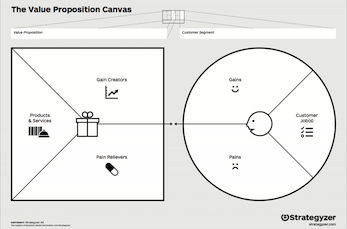Entrepreneurs guide for successful business operation
Opening a business is tough, even if we have a great product idea.
How do we become successful on the market? How will our product create revenue? What expenses are to be expected?
Those are the questions entrepreneurs often face when entering the market with a new product. A business model can help answer those questions. There are several ways to create business models and one of the most used and most straightforward method is called The Business Model Canvas (BMC).
The BMC is a collaborative visual tool helping business people create a shared understanding around business models. It is a predefined template consisting of 9 building blocks: customer segments, value propositions, channels, customer relationships, revenue streams, key resources, key partnerships and cost structures. Each block is related to all the others ensuring an overarching view of the business operations.
What are these building blocks? They describe all aspects to be considered when starting a new business, or releasing a new product.
– The Value Propositions and Customer Segments blocks are derived from the Value Proposition Canvas (which is a plug-in tool for the BMC) and describe the products and services that are offered to the customers. Value Propositions seek to solve customer problems and satisfy customer needs.
– They are delivered to customers through Communication, Distribution and Sales Channels.
– Customer Relationship describes the relationships established with each customer segment.
– Revenue Streams tells how money is gained from Value Propositions.
– Key Resources defines the most important assets required to operate the business, while
– Key Activities describes the most important things needed to be done.
– Key Partners describes the partnerships obtained through networking with the partners required to make the business work.
– Cost Structure shows the most important costs incurred during business operation.
This simple tool can be used by startups or new ventures just as well as by established companies releasing new products. In each case, different advantages and disadvantages need to be dealt with when creating the canvas, like utilisation of existing assets or slow decision making due to complex organisational hierarchies. But in both cases an important aspect needs to be considered, that is the Business Environment, as canvases are not created for isolated businesses. Stay tuned for an upcoming blogpost about Business Environment Map.
To learn more about Value Proposition Canvas and Business Model Canvas, join our Advanced Product Owner classes.

